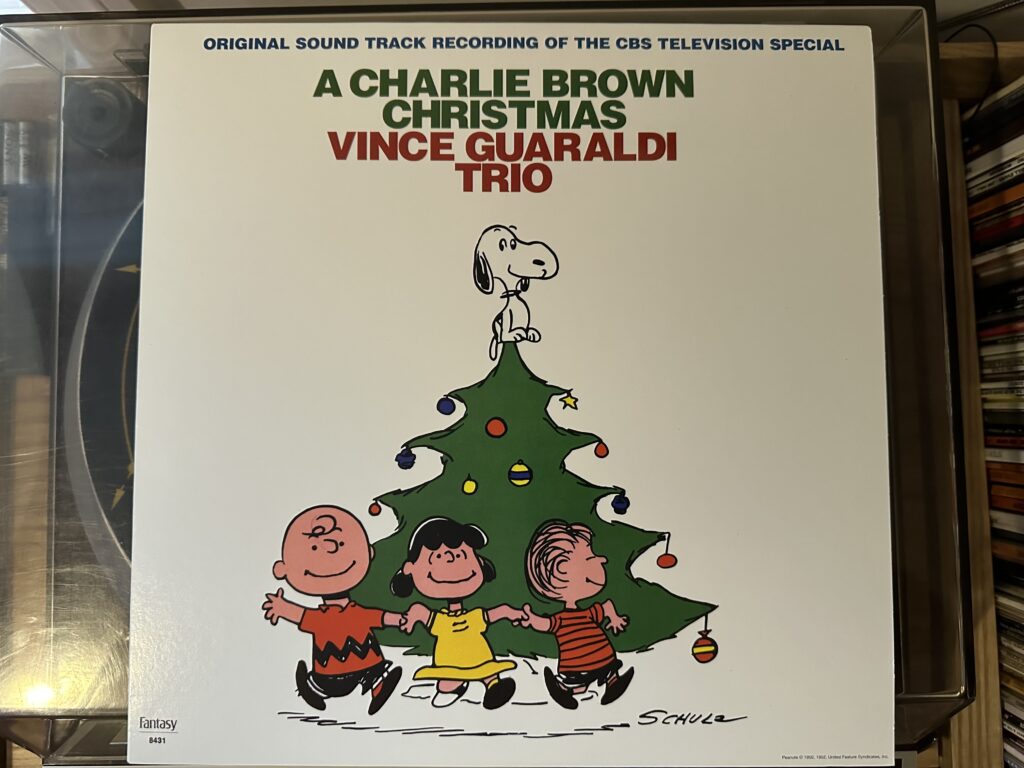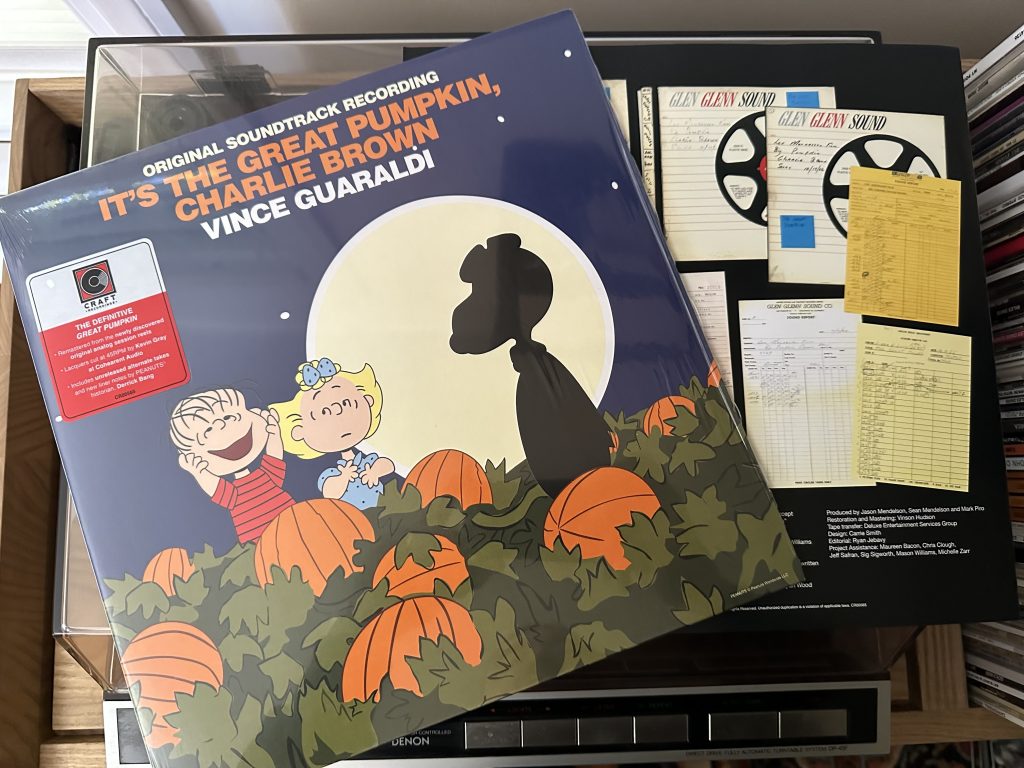
Album of the Week, December 2, 2023
It seems to have come from nowhere and to always have been here. For my lifetime, there has always been A Charlie Brown Christmas, and there has always been a jazz piano trio in the background playing to underscore Schulz’s scenes of comedy and pathos, as Charlie Brown and Linus (and Schroeder, Shermy, Violet, Pig-Pen, Frieda, Sally, Lucy and Snoopy) grapple with finding deeper meaning in a holiday designed to stay flashy and shallow at every turn. But it was by no means a destined work, and it was only through the happiest of accidents that Vince Guaraldi was signed up to write the soundtrack that made him famous, and brought jazz into the hearts of countless kids.
Charles Schulz started Peanuts in 1950, after several failed starts in comics (of which the single-panel strip “Li’l Folks” is probably the most worth seeking out). By the early 1960s, the strip was a complete phenomenon, having originated collections of books and merchandise as well as reaching broad nationwide syndication. But television had mostly eluded Schulz. Animated segments featuring the characters were produced for the Tennessee Ernie Ford TV show, but a documentary special, A Boy Named Charlie Brown, was produced in 1963 but never picked up.
It was in the construction of that special that producer Lee Mendelson happened to be listening to the radio and heard Vince Guaraldi’s “Cast Your Fate to the Wind” (from the album Jazz Impressions of Black Orpheus and never intended as a single— it was released in 1962 as the b-side to the bossa nova “Samba de Orpheus”) and hired him to record cues for the documentary. Guaraldi, excited, called Mendelson one night and played him “Linus and Lucy,” which apparently came to him fully formed. While the documentary was never released, Guaraldi released the album Jazz Impressions of A Boy Named Charlie Brown, and this association set him up to continue working with Mendelson when the Coca-Cola Company agreed to sponsor A Charlie Brown Christmas.
Guaraldi convened a few different recording sessions between September 17 and October 28, 1965; the players were not noted on the session reels, but it appears Jerry Granelli and Fred Marshall played drums and bass on most of the session, with Colin Bailey and Monty Budwig appearing on a few tracks. Listening to the full sessions, which were released in a super deluxe edition last year, it’s apparent that Guaraldi brought most of the arrangements with him to the group, only working out a few in the studio.
“O Tannenbaum” captures the vibe of the sessions from the beginning. Played solo by Guaraldi on the piano in free time during the first chorus, the drums and bass enter behind him at the beginning to the second and the piece clicks into a jazz shuffle. The sound is kept mellow; the drummer sticks to brushes throughout and the bassist stays to a simple walked line for the next few choruses. When the bass gets a solo chorus, the drummer adds some hits on the hi-hat and snare, but is still kept back in the mix, keeping the overall feeling mellow and contemplative.
“What Child is This” appears late in the recording sessions. The traditional English carol, based on the tune “Greensleeves,” is opened with a rippling arpeggio that introduces the tune and repeats between verses; the tune is otherwise played straight by the combo, and the minor key reinforces the wistful feeling of the album. It’s a quick performance, over in only a few verses.
“My Little Drum” sees the appearance of a lighter tone, with a children’s chorus (the children’s choir of St. Paul’s Episcopal Church in San Rafael, California) providing a vocalise over the trio. Credited to Guaraldi, the tune is a re-working of Katherine Davis’s “Carol of the Drum” aka “The Little Drummer Boy,” with the drummer adding some subtle salsa flavor behind the bass and piano, who mostly play the melody straight.
The more upbeat feeling continues with the soundtrack’s most famous song (and the first real Guaraldi composition), “Linus and Lucy.” The famous walking bass arpeggio is doubled in the left hand of the piano and the acoustic bass, while the drummer mostly keeps time with hits on 2 and 4 and a shaker. The first bridge veers over into samba territory, with the ensemble relaxing into the tune; the second bridge does a more straightforward blues with a walking bass line. It is more complicated to describe than it is to listen to; aurally it’s like a straight shot of dopamine to my Gen-X cortex.
“Christmas Time is Here (instrumental)” appears twice on the album. The first rendition is kept simple by the trio, with the bass taking the second verse as a walking solo. The drum sticks to brushwork throughout; the final verse has a tremolo effect in both the piano and the arco bass. It’s delicate and wonderful, and more than a little wistful in the chord progression. The vocal version follows as the lead track of Side 2, and features the children’s choir singing lyrics that Lee Mendelson claims to have written on the back of an envelope in “about ten minutes.” The song has become a standard, having been covered by David Benoit, Ron Escheté, Patti Austin, Debby Boone, Mel Tormé, Rosemary Clooney, R.E.M., Stone Temple Pilots, Khruangbin, Sarah McLachlan, Diana Krall, and El Vez, among others. Jerry Granelli once commented, “Vince always wanted to write a standard. So he made it.”
“Skating,” another Guaraldi original, is less widely covered but no less delightful. A study in the use of arpeggios in melody, it’s a relaxed, jaunty melody that soundtracks one of the best physical comedy moments in the special, as Snoopy lures the kids out to skate on the ice only to play “crack the whip” and send them flying.
“Hark the Herald Angels Sing,” the number that closes the actual television special, here appears partway through side 2, with a children’s choir in full “loo loo loo” mode and Guaraldi on the Wurlitzer organ. It’s charming and you can hear the late night of the recording session in the kids’ voices; they were apparently taken for ice cream after the session concluded to compensate.
“Christmas is Coming” is the last of the Guaraldi originals, and it’s a bop. The drummer is let off the leash as the band leans into the tune, bouncing between straight ahead jazz and the samba-inflected bridge. It would have been interesting to hear some of Guaraldi’s later bands, like the one on A Charlie Brown Thanksgiving, tackle this tune with a horn section.
“Für Elise” signals one of the few appearances of Schroder as anything other than a background character, as he plays the Beethoven melody while Lucy tries vainly to get his attention. Robert Wells and Mel Tormé’s classic “The Christmas Song” follows, with a solo rendition by Guaraldi for the first verse and chorus; the bass and drums join quietly behind him for the second verse and chorus. Tormé and Wells’ classic has received many cover performances, definitively by Nat King Cole; this version plays it straight and it’s completely unaffected.
“Greensleeves” was added to the definitive running order of the album with the first CD recording in 1988. An alternate version of “What Child Is This,” it was recorded late in the sessions, along with “The Christmas Song,” when the team realized they needed some additional songs to fill out the album. “Greensleeves” returns to the sound world of the second track with a slightly different arpeggiated interlude used in place of the triplets from the earlier track. Listening to the alternate tracks, it’s clear that Guaraldi and Mendelson were looking for a particular mood, trying and discarding arrangements that owed debts to Coltrane and to bossa nova. The band is allowed to stretch out more in this final track, adding a depth of exploratory sound to the album’s final four minutes and playing into different tonalities before concluding.
So we’ve wandered through Vince Guaraldi’s music, forwards and backwards, until we arrived at his most spectacular and most humble production. A Charlie Brown Christmas feels like a standard that has always existed because it captures the peaceful, meditative nature of the holiday alongside the frantic, mysterious, and joyful. Three of the tunes—“Skating,” “Christmas Time is Here,” and “Linus and Lucy”—can be said to have ascended to the realm of jazz and holiday standards. Not bad for 30 minutes of television anchored by a simple jazz piano trio. We’ll come back to Guaraldi once more at some point in the future as we wander through my collection; next week, though, we’ll touch a different Christmas tradition.
You can listen to today’s album here:

